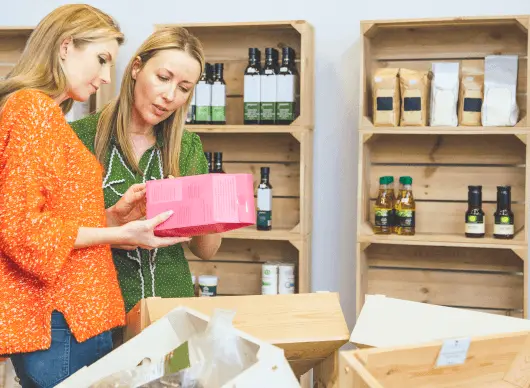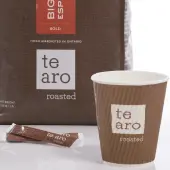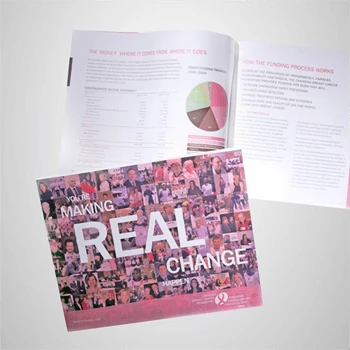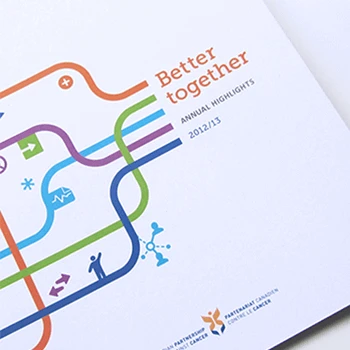What makes brand packaging design critical for delivering the desired brand experience?
Brand packaging design ensures consistent branding right out of the box, creating powerful first impressions that convey your desired personality and brand experience. If your customer's first impression of your product is through its packaging, you want that packaging to simply deliver the desired brand experience. Using our Experience Thinking framework, packaging becomes a critical touchpoint that connects brand, product, content, and service experiences into a cohesive customer journey.
Tip: Consider packaging as your 24/7 brand ambassador - it communicates your brand values and personality even when no sales staff or marketing materials are present.
How does packaging design fit into the broader brand application strategy?
Packaging is one of the most important brand applications that must work consistently with other brand expressions. As part of your brand system, packaging should reflect the same brand identity, tone of voice, and visual elements as your other touchpoints. Packaging design follows brand patterns and applications that show how identity elements work in different contexts, ensuring consistent brand recognition across all customer interactions.
Tip: Audit how your packaging will appear alongside other brand applications like marketing materials, websites, and retail environments to ensure visual consistency and brand coherence.
What role does packaging play in the customer experience lifecycle?
Packaging influences multiple phases of the customer experience lifecycle, from initial awareness and consideration through purchase, unboxing, usage, and potential repurchase decisions. In the customer experience journey, packaging often represents the transition from prospect to customer, creating emotional connections that drive loyalty and advocacy. Effective packaging design supports the entire experience lifecycle by reinforcing brand promises and creating memorable moments.
Tip: Map out every moment customers interact with your packaging throughout their journey - from shelf visibility to disposal - and design for each touchpoint intentionally.
How does packaging design communicate brand personality and values?
Packaging communicates brand personality through visual design choices, material selection, structural design, and functional features that reflect organizational values. Every packaging element - from color palette and typography to texture and opening mechanism - should reinforce your brand persona and positioning. The goal is creating packaging that feels authentic to your brand while resonating with customer expectations and preferences.
Tip: Create packaging mood boards that capture your brand personality before designing specific packaging elements - this visual reference ensures all design decisions align with intended brand character.
What business objectives should guide packaging design decisions?
Packaging design should support objectives including brand differentiation, customer acquisition, loyalty building, premium positioning, and operational efficiency. Business goals inform decisions about packaging complexity, material quality, production costs, and sustainability approaches. Effective packaging balances brand expression with practical considerations like protection, shelf life, shipping requirements, and regulatory compliance.
Tip: Prioritize business objectives before design development begins - clear goals help make better trade-off decisions when balancing aesthetics, functionality, and budget constraints.
How do you balance brand consistency with product line differentiation in packaging?
Balanced packaging maintains recognizable brand elements while allowing appropriate differentiation for different products, markets, or customer segments. This requires establishing clear brand architecture that defines which elements remain consistent versus which can adapt for specific applications. The packaging system should create family resemblance while enabling individual product personality and positioning within the broader brand portfolio.
Tip: Develop packaging architecture guidelines that specify which brand elements are non-negotiable versus which can be modified for different products or market segments.
What makes packaging design emotionally engaging for target audiences?
Emotionally engaging packaging creates immediate connections through visual appeal, tactile experiences, functional benefits, and symbolic meaning that resonates with customer values and aspirations. Engagement emerges from understanding customer motivations, purchase contexts, and emotional triggers that influence buying decisions. The most successful packaging designs make customers feel positive emotions before, during, and after interaction with the product.
Tip: Research the emotional journey customers experience when shopping for your product category - design packaging that supports positive emotions and addresses potential concerns or hesitations.
What are the essential elements of effective packaging design?
Essential packaging elements include structural design, visual identity application, typography hierarchy, color systems, imagery or graphics, material selection, and functional features. These elements must work together to create cohesive brand communication while serving practical functions like product protection, information communication, and ease of use. Each element should reinforce the overall brand experience and support customer decision-making processes.
Tip: Create a packaging element hierarchy that prioritizes brand recognition, product identification, and key messaging to ensure the most important information is immediately visible and memorable.
How do you determine the optimal packaging structure and format?
Packaging structure decisions are based on product protection requirements, brand positioning objectives, customer usage patterns, retail environment needs, and production efficiency considerations. The optimal structure balances functional performance with brand expression while considering factors like shipping costs, storage efficiency, and environmental impact. Structure should enhance rather than compromise the brand experience.
Tip: Test different structural approaches with actual products and real-world handling scenarios before finalizing design - theoretical solutions don't always work in practice.
What role does sustainability play in modern packaging design?
Sustainability considerations include material selection, production processes, transportation efficiency, end-of-life disposal, and overall environmental impact. Sustainable packaging design balances environmental responsibility with brand expression and functional requirements. Many customers increasingly value sustainable packaging as a reflection of brand values and social responsibility, making sustainability both an ethical and strategic business consideration.
Tip: Research sustainable packaging options early in the design process rather than treating sustainability as an afterthought - sustainable solutions often require different design approaches and material considerations.
How do you optimize packaging for different retail environments?
Retail optimization considers shelf placement, lighting conditions, competitive context, viewing angles, and shopping behaviors specific to different retail formats. Packaging must perform effectively whether displayed in premium department stores, discount retailers, online marketplaces, or specialty boutiques. Design approaches may need adaptation for different retail contexts while maintaining core brand recognition and appeal.
Tip: Visit actual retail environments where your product will be sold and observe customer shopping behaviors - design for real-world retail conditions rather than ideal presentation scenarios.
What technical constraints affect packaging design possibilities?
Technical constraints include production capabilities, material limitations, printing technologies, assembly processes, filling equipment compatibility, and regulatory requirements. Understanding technical constraints early prevents designs that look good conceptually but cannot be produced efficiently or cost-effectively. Technical planning also addresses quality control, consistency requirements, and scalability for different production volumes.
Tip: Involve production partners early in the design process to understand capabilities and limitations rather than discovering technical problems after design completion.
How do you incorporate interactive or innovative features into packaging design?
Interactive features might include special opening mechanisms, textural elements, color-changing materials, digital integration, or multi-functional design elements that enhance user experience. Innovation should serve strategic purposes rather than being novel for novelty's sake. Interactive elements should reinforce brand personality while providing genuine functional or emotional benefits to customers.
Tip: Test innovative packaging features with real customers to ensure they enhance rather than complicate the user experience - innovation should solve real problems or create genuine delight.
What information hierarchy works best for packaging communication?
Effective information hierarchy prioritizes brand identification, product name, key benefits, and essential details in order of importance and customer needs. Hierarchy considers viewing distance, reading sequence, legal requirements, and decision-making factors relevant to purchase contexts. Clear hierarchy helps customers quickly understand what the product is, who makes it, and why they should choose it over alternatives.
Tip: Test information hierarchy with customers in simulated shopping conditions to ensure the most important information is noticed and understood within typical browsing timeframes.
How does packaging design influence the unboxing experience?
Unboxing experience design considers the emotional journey from package opening through product reveal and initial interaction. This includes opening mechanisms, internal presentation, protective elements, and any surprise or delight moments that reinforce brand values. The unboxing experience can create shareable moments that extend brand reach through social media while building emotional connections with customers.
Tip: Design the unboxing sequence as a deliberate experience with multiple reveal moments rather than just protecting the product - each step should build anticipation and excitement.
What makes packaging user-friendly across different demographics?
User-friendly packaging considers physical capabilities, cognitive processing, cultural preferences, and accessibility needs across diverse customer groups. This includes considerations for aging populations, visual or motor impairments, different cultural reading patterns, and varying levels of technical familiarity. Universal design principles can make packaging accessible while maintaining aesthetic appeal and brand expression.
Tip: Test packaging usability with representatives from your target demographics, including customers with different physical abilities and cultural backgrounds to identify potential accessibility barriers.
How do you design packaging that encourages repeat purchases?
Repeat purchase packaging creates positive associations through consistent quality experiences, convenience features, reusability opportunities, and loyalty program integration. The packaging should remind customers of the positive experience with your brand while making repurchase decisions easy and appealing. Design elements might include refillable components, collectible features, or functional secondary uses.
Tip: Consider packaging lifecycle beyond first use - design elements that provide ongoing value or serve as brand reminders can influence future purchase decisions.
What packaging features enhance product protection and freshness?
Protective packaging features include barrier properties, cushioning systems, tamper evidence, freshness indicators, and resealable closures that maintain product quality throughout the distribution and usage lifecycle. Protection features should be invisible to customers while ensuring product arrives in perfect condition. The best protective packaging enhances brand perception by demonstrating care for product quality and customer satisfaction.
Tip: Test packaging protection under realistic distribution conditions including temperature changes, handling stress, and storage duration to ensure adequate protection without over-packaging.
How does packaging design support product education and usage guidance?
Educational packaging provides clear instructions, benefit explanations, usage tips, and troubleshooting guidance that help customers get maximum value from their purchase. Education can be integrated through visual demonstrations, QR codes linking to digital content, or progressive disclosure that reveals information as needed. Good educational packaging reduces support needs while increasing customer satisfaction and product success.
Tip: Prioritize the most critical educational information for packaging inclusion and use digital integration for detailed instructions - packaging space is limited but digital content is unlimited.
What role does packaging play in building emotional brand connections?
Emotional connections through packaging emerge from authentic brand expression, premium tactile experiences, memorable visual moments, and alignment with customer values and aspirations. Emotional packaging tells your brand story through every design choice and creates feelings that customers associate with your brand. These emotional connections drive loyalty, word-of-mouth recommendations, and premium price acceptance.
Tip: Focus on one or two primary emotions you want customers to feel when interacting with your packaging and ensure every design element supports those emotional goals.
How do you create packaging that photographs well for social media sharing?
Social media-friendly packaging considers visual appeal in various lighting conditions, interesting angles or details worth photographing, and elements that create story-worthy moments. Photogenic packaging often includes clean design lines, appealing color combinations, unexpected details, or interactive elements that encourage documentation and sharing. The goal is creating packaging that customers want to show off to their networks.
Tip: Test packaging photography under typical smartphone conditions and social media filters to ensure your design translates well to digital sharing platforms.
What production considerations affect packaging design feasibility?
Production feasibility includes manufacturing capabilities, material availability, printing technology limitations, assembly complexity, quality control requirements, and scalability for different volume needs. Production planning addresses setup costs, lead times, minimum order quantities, and potential supply chain disruptions. Early production consultation prevents designs that cannot be manufactured efficiently or cost-effectively.
Tip: Develop relationships with multiple production partners to understand different capabilities and maintain backup options for critical packaging components.
How do you manage packaging costs while maintaining brand quality?
Cost management requires understanding the relationship between material choices, production complexity, order volumes, and quality standards. Cost optimization might involve material substitutions, structural simplifications, or production process improvements that maintain brand impact while reducing expenses. The goal is finding the optimal balance between cost efficiency and brand expression that supports business objectives.
Tip: Create cost models that show how different design choices affect total packaging costs including materials, production, shipping, and storage to make informed trade-off decisions.
What timeline should we expect for packaging design and production?
Packaging development typically requires 12-20 weeks from initial design through production-ready samples, depending on complexity and approval processes. Timeline includes design development (4-6 weeks), prototyping and testing (3-4 weeks), production setup (2-4 weeks), and initial production (3-6 weeks). Complex packaging or new production techniques may require longer development periods.
Tip: Plan packaging development timeline with adequate buffer for unexpected challenges and coordinate with product launch schedules to avoid delays in market introduction.
How do you ensure packaging quality consistency across production runs?
Quality consistency requires detailed specifications, production standards, regular monitoring, and correction procedures when variations occur. Quality systems address color accuracy, print registration, structural integrity, and functional performance across different production batches. Consistent quality maintains brand perception while preventing customer disappointment or returns due to packaging defects.
Tip: Establish quality standards with measurable criteria and regular audit schedules rather than relying on subjective visual assessment for quality control.
What regulatory and compliance requirements affect packaging design?
Regulatory requirements vary by product category and market and may include labeling standards, material safety, recycling symbols, age restrictions, health warnings, and nutritional information. Compliance planning addresses different regional requirements for international distribution while maintaining design consistency where possible. Non-compliance can result in costly recalls, fines, or market access restrictions.
Tip: Involve regulatory specialists early in design development to understand requirements and build compliance into the design rather than retrofitting labels or making costly revisions.
How do you plan for packaging scalability as business grows?
Scalable packaging design considers how production volumes, distribution requirements, and market expansion will affect packaging needs over time. Scalability planning addresses production capacity, material sourcing, cost structures, and design flexibility for future product variations or market adaptations. Good scalability planning prevents the need for complete packaging redesign as business grows.
Tip: Design packaging systems that can accommodate volume growth and product line expansion rather than optimizing only for current production levels and product offerings.
What logistics considerations influence packaging design decisions?
Logistics considerations include shipping protection, stacking efficiency, warehouse storage, handling requirements, and distribution channel compatibility. Packaging must protect products during transportation while optimizing space utilization and handling efficiency. Logistics-optimized packaging reduces shipping costs, minimizes damage, and improves overall supply chain efficiency while maintaining brand presentation quality.
Tip: Analyze your complete distribution chain from manufacturing through final delivery to identify packaging requirements and optimization opportunities at each stage.
How does packaging design support premium positioning and price justification?
Premium packaging communicates quality through material selection, structural sophistication, finishing techniques, and attention to detail that justifies higher price points. Premium positioning requires packaging that feels substantial, looks sophisticated, and provides experiences that match customer expectations for premium products. The packaging itself becomes part of the value proposition that customers receive for their investment.
Tip: Research packaging in premium product categories to understand customer expectations and quality cues that signal value and justify price premiums.
What packaging strategies work for different market segments?
Different market segments have varying packaging preferences based on values, shopping behaviors, price sensitivity, and lifestyle considerations. Mass market packaging prioritizes efficiency and clear communication, while luxury segments expect sophisticated materials and presentation. Understanding segment preferences enables packaging strategies that resonate with intended customers while supporting appropriate positioning.
Tip: Analyze packaging preferences within your target segments through research and observation rather than assuming universal preferences across different customer groups.
How do you differentiate packaging from competitors while maintaining category recognition?
Effective differentiation identifies unique positioning opportunities within category conventions while maintaining enough familiarity for easy customer navigation. Differentiation might focus on specific design elements, functional features, sustainability approaches, or emotional positioning that sets your brand apart. The goal is standing out memorably while fitting appropriately within customer expectations for your product category.
Tip: Map competitive packaging landscapes systematically to identify differentiation opportunities and white space positioning that competitors haven't claimed effectively.
What role does packaging play in brand portfolio management?
Portfolio packaging management ensures individual products support broader brand architecture while maintaining their distinct positioning and appeal. This includes coordinating visual systems, managing brand hierarchy, and enabling cross-selling opportunities through packaging design. Portfolio considerations also address cannibalization risks and ensure packaging supports intended customer perception of product relationships.
Tip: Create packaging architecture guidelines that define relationships between different products and ensure portfolio coherence while allowing individual product personality expression.
How does packaging design support international market expansion?
International packaging considers cultural preferences, regulatory differences, language requirements, and local market expectations while maintaining brand recognition across regions. Global packaging strategies might include modular designs that accommodate local adaptations or universal approaches that work across diverse markets. Planning addresses production logistics, cost implications, and brand consistency across international operations.
Tip: Research cultural packaging preferences and regulatory requirements in target international markets early to inform design decisions that facilitate global expansion.
What packaging approaches support direct-to-consumer versus retail distribution?
Direct-to-consumer packaging prioritizes shipping protection, unboxing experience, and brand storytelling without retail shelf considerations. Retail packaging focuses on shelf impact, category navigation, and point-of-sale appeal. Many brands need dual packaging strategies or hybrid approaches that work effectively in both channels while maintaining brand consistency and cost efficiency.
Tip: Map the customer journey differences between online and retail purchases to understand how packaging requirements vary and design solutions that optimize for each channel.
How do you measure packaging effectiveness and market impact?
Packaging effectiveness measurement includes brand recognition studies, purchase influence research, customer satisfaction tracking, and business impact assessment. Measurement might examine shelf visibility, emotional response, perceived value, and competitive comparison. Effective measurement provides insights for packaging optimization and demonstrates return on packaging investment through improved sales and brand metrics.
Tip: Establish packaging performance baselines before implementing new designs so you can measure actual impact on recognition, preference, and business results.
How is AI transforming packaging design development and optimization?
AI enhances packaging design through automated competitive analysis, consumer preference prediction, structural optimization, and design variation generation. AI tools can analyze successful packaging patterns, predict market reception, optimize material usage, and generate design alternatives for testing. AI also supports packaging personalization, supply chain optimization, and quality control automation. However, creative strategy, brand alignment, and emotional connection require human insight and decision-making.
Tip: Use AI tools to augment human creativity and analysis capabilities rather than replace strategic thinking - AI excels at pattern recognition and optimization but human judgment remains essential for brand strategy and emotional resonance.
What emerging technologies are influencing packaging design possibilities?
Emerging technologies include smart packaging with digital integration, sustainable material innovations, advanced printing techniques, interactive features, and Internet of Things connectivity. These technologies enable new functionality like freshness monitoring, authentication verification, personalized messaging, and enhanced customer engagement. Technology adoption should serve strategic purposes while remaining cost-effective and user-friendly.
Tip: Evaluate emerging technologies based on customer value and business impact rather than novelty appeal - successful technology integration solves real problems or creates genuine benefits.
How do you integrate digital experiences with physical packaging?
Digital integration might include QR codes, NFC tags, augmented reality features, or smartphone app connectivity that extend packaging functionality beyond physical limitations. Digital integration can provide product information, usage instructions, entertainment content, loyalty program access, or social sharing opportunities. The goal is seamless connection between physical and digital experiences that enhance rather than complicate customer interaction.
Tip: Design digital integration that provides clear value to customers rather than using technology for its own sake - unnecessary digital features can create confusion rather than enhancement.
What sustainable packaging innovations are available for brand differentiation?
Sustainable innovations include biodegradable materials, renewable resources, minimal packaging approaches, refillable systems, and circular economy designs that minimize environmental impact. Sustainable packaging can differentiate brands while appealing to environmentally conscious customers. Innovation should balance environmental benefits with functional performance and cost considerations while communicating sustainability benefits effectively.
Tip: Research the environmental credentials and lifecycle impact of sustainable packaging options thoroughly rather than relying on marketing claims - authentic sustainability requires verified environmental benefits.
How do you approach packaging personalization and customization?
Packaging personalization might include variable printing, customizable elements, seasonal variations, or limited edition designs that create unique customer experiences. Personalization strategies should balance individual appeal with production efficiency and brand consistency. Technology enables increasing personalization possibilities while maintaining cost-effectiveness for different production volumes and market segments.
Tip: Start with simple personalization approaches that can be produced efficiently before investing in complex customization systems - test customer response to personalization before major production investments.
What role does data analytics play in packaging design optimization?
Data analytics can inform packaging decisions through customer behavior analysis, A/B testing results, sales performance tracking, and market trend identification. Analytics help optimize packaging elements based on actual performance data rather than assumptions. Data sources might include retail sales, online behavior, customer feedback, and competitive analysis to guide packaging improvements and innovations.
Tip: Collect packaging performance data consistently across different markets and time periods to identify patterns and opportunities for optimization rather than relying on one-time studies.
How do you future-proof packaging design for changing market conditions?
Future-proofing requires flexible design systems that can adapt to changing regulations, customer preferences, sustainability requirements, and technology developments. Adaptable packaging considers modular design approaches, scalable production systems, and evolving market trends. Future-proofing also involves monitoring emerging developments and planning adaptation strategies rather than reactive redesign when changes occur.
Tip: Build adaptability into packaging design systems rather than optimizing only for current conditions - flexible foundations enable evolution without complete redesign as markets change.
What does the packaging design process look like when working with Akendi?
Our packaging design process begins with strategic foundation review using our Experience Thinking framework. We ensure packaging design connects seamlessly with your brand, content, product, and service experiences to deliver consistent branding right out of the box. The process includes market research, design development, prototype testing, production planning, and implementation support. We maintain collaborative communication while bringing specialized packaging expertise to create powerful brand packaging.
Tip: Prepare for initial meetings by gathering existing packaging examples, competitive references, and specific business objectives that packaging design should support.
How do you coordinate with our internal product and brand personnel?
Coordination requires understanding your product development processes, brand management systems, and decision-making hierarchies. We work collaboratively with your product, brand, marketing, and operations personnel to ensure packaging design enhances existing processes and supports business objectives. Our role includes building internal capabilities while providing specialized packaging expertise and market perspective.
Tip: Identify all internal stakeholders who will influence or be affected by packaging decisions and establish clear communication protocols to ensure efficient collaboration.
What level of involvement is expected from our internal stakeholders?
Internal involvement includes strategic input, design feedback, technical requirement specification, production coordination, and implementation oversight. We provide structured frameworks for efficient collaboration while respecting operational constraints and approval processes. Key stakeholders typically include product management, brand leadership, operations personnel, and regulatory specialists who understand compliance requirements.
Tip: Designate project coordinators who can facilitate internal stakeholder participation and make timely decisions to maintain project momentum and quality.
How do you handle complex regulatory and technical requirements?
Complex requirements require understanding regulatory landscapes, technical constraints, production capabilities, and compliance standards that affect packaging design possibilities. We coordinate with legal, regulatory, and technical specialists to ensure designs meet all necessary requirements while maximizing brand impact and customer appeal. Our approach balances regulatory compliance with creative excellence and business objectives.
Tip: Involve regulatory and technical specialists early in the design process to understand constraints and opportunities rather than discovering limitations after design development.
What ongoing support do you provide after packaging design completion?
Post-completion support includes production coordination, quality monitoring, performance tracking, market feedback analysis, and optimization guidance. We help manage packaging rollout, address production challenges, and provide consultation for packaging evolution or line extensions. Our relationship often extends beyond initial design as organizations benefit from expertise during implementation and ongoing packaging management.
Tip: Plan for ongoing packaging management needs including production oversight, quality monitoring, and potential design evolution rather than treating completion as the end of the relationship.
How do you ensure knowledge transfer and internal capability building?
Knowledge transfer includes documentation of design decisions, production specifications, quality standards, and packaging management processes. We provide education on packaging best practices, supplier management, and brand consistency maintenance. Our goal is building internal capabilities while remaining available for consultation on complex packaging challenges and strategic evolution decisions.
Tip: Identify internal personnel who will be responsible for ongoing packaging management and involve them actively in the design process for hands-on learning and capability building.
What makes Akendi's approach to packaging design distinctive?
Our Experience Thinking framework sets us apart by creating packaging that supports connected experiences across all customer touchpoints. We examine how packaging works within brand communications, product experiences, content delivery, and service interactions to ensure consistent brand experience delivery. With over 220 clients across technology, energy, media, and public sectors, we bring deep cross-industry experience to packaging development. Our approach ensures packaging becomes a tool for creating meaningful customer experiences rather than just product protection.
Tip: Consider how your packaging will support improved customer experiences throughout the entire product lifecycle rather than just focusing on shelf appeal or protection requirements.












